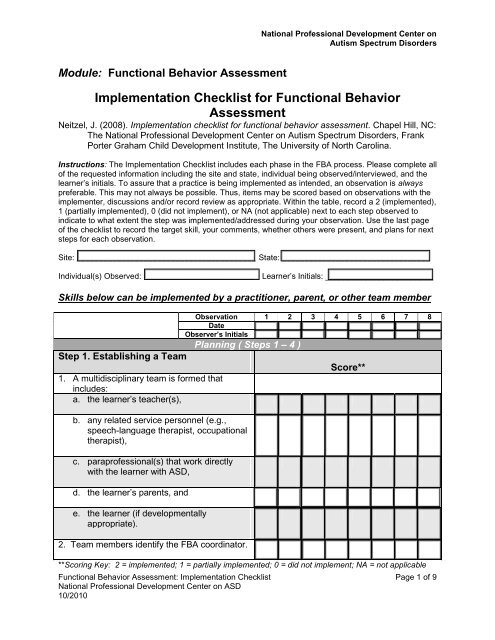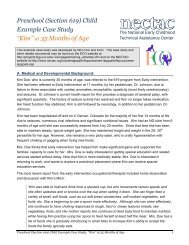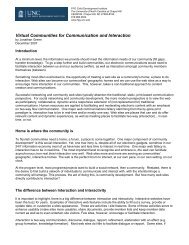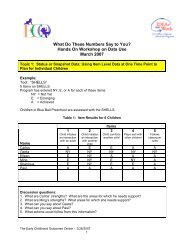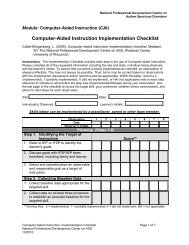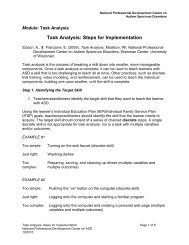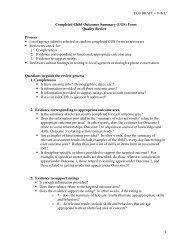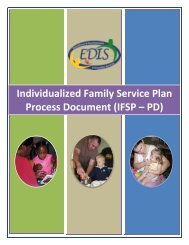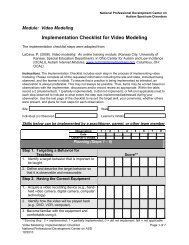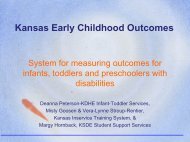Implementation Checklist for Functional Behavior Assessment
Implementation Checklist for Functional Behavior Assessment
Implementation Checklist for Functional Behavior Assessment
You also want an ePaper? Increase the reach of your titles
YUMPU automatically turns print PDFs into web optimized ePapers that Google loves.
National Professional Development Center onAutism Spectrum DisordersModule: <strong>Functional</strong> <strong>Behavior</strong> <strong>Assessment</strong><strong>Implementation</strong> <strong>Checklist</strong> <strong>for</strong> <strong>Functional</strong> <strong>Behavior</strong><strong>Assessment</strong>Neitzel, J. (2008). <strong>Implementation</strong> checklist <strong>for</strong> functional behavior assessment. Chapel Hill, NC:The National Professional Development Center on Autism Spectrum Disorders, FrankPorter Graham Child Development Institute, The University of North Carolina.Instructions: The <strong>Implementation</strong> <strong>Checklist</strong> includes each phase in the FBA process. Please complete allof the requested in<strong>for</strong>mation including the site and state, individual being observed/interviewed, and thelearner’s initials. To assure that a practice is being implemented as intended, an observation is alwayspreferable. This may not always be possible. Thus, items may be scored based on observations with theimplementer, discussions and/or record review as appropriate. Within the table, record a 2 (implemented),1 (partially implemented), 0 (did not implement), or NA (not applicable) next to each step observed toindicate to what extent the step was implemented/addressed during your observation. Use the last pageof the checklist to record the target skill, your comments, whether others were present, and plans <strong>for</strong> nextsteps <strong>for</strong> each observation.Site: ________________________________________ State: _________________________________Individual(s) Observed: ________________________ Learner’s Initials: ________________________Skills below can be implemented by a practitioner, parent, or other team memberObservation 1 2 3 4 5 6 7 8DateObserver’s InitialsPlanning ( Steps 1 – 4 )Step 1. Establishing a TeamScore**1. A multidisciplinary team is <strong>for</strong>med thatincludes:a. the learner’s teacher(s),b. any related service personnel (e.g.,speech-language therapist, occupationaltherapist),c. paraprofessional(s) that work directlywith the learner with ASD,d. the learner’s parents, ande. the learner (if developmentallyappropriate).2. Team members identify the FBA coordinator.**Scoring Key: 2 = implemented; 1 = partially implemented; 0 = did not implement; NA = not applicable<strong>Functional</strong> <strong>Behavior</strong> <strong>Assessment</strong>: <strong>Implementation</strong> <strong>Checklist</strong> Page 1 of 9National Professional Development Center on ASD10/2010
National Professional Development Center onAutism Spectrum DisordersModule: <strong>Functional</strong> <strong>Behavior</strong> <strong>Assessment</strong>Step 2. Identifying the Interfering<strong>Behavior</strong>1. Identify the interfering behavior that is mostproblematic <strong>for</strong> the learner that will be thefocus of the FBA.2. After identifying the interfering behavior, theteam members determine:a. how long the behavior has beeninterfering with the learner’s developmentand/or learning,b. if the behavior involves aggression ordamage to property,c. if the behavior is the result ofenvironmental factors (e.g., lighting,noise level),d. if the interfering is occurring because thelearner is being asked to demonstrate askill that he/she cannot per<strong>for</strong>m,e. when and where the behavior occurs,f. other behaviors the learner exhibitsimmediately be<strong>for</strong>e the behavior occurs,andg. what happens immediately after theinterfering behavior occurs.Step 3. Collecting Baseline Data1. Prior to designing and implementing anintervention, use indirect assessmentmethods that include:a. reviewing previous and current recordsandObservation 1 2 3 4 5 6 7 8DateObserver’s InitialsScore****Scoring Key: 2 = implemented; 1 = partially implemented; 0 = did not implement; NA = not applicable<strong>Functional</strong> <strong>Behavior</strong> <strong>Assessment</strong>: <strong>Implementation</strong> <strong>Checklist</strong> Page 2 of 9National Professional Development Center on ASD10/2010
National Professional Development Center onAutism Spectrum DisordersModule: <strong>Functional</strong> <strong>Behavior</strong> <strong>Assessment</strong>Step 3. Collecting Data (cont.)b. conducting <strong>for</strong>mal and in<strong>for</strong>malinterviews with school staff, familymembers, and the learner with ASD.2. Clearly describe the interfering behavior andidentify data collection measures that will beused to assess the interfering behavior priorto designing and implementing theintervention.3. Determine how long baseline data should becollected and who will collect it.4. Use direct observation methods thatgenerally include:a. using A-B-C data charts,b. using scatterplots,c. using standardized behavior ratingscales,d. conducting learner motivationassessments, and/ore. conducting learner rein<strong>for</strong>cer preferenceassessments.Observation 1 2 3 4 5 6 7 8DateObserver’s InitialsScore**5. Use indirect and direct assessment results toidentify:a. where the behavior happens,b. with whom the behavior occurs,c. when the behavior happens,d. activities during which the behavioroccurs,**Scoring Key: 2 = implemented; 1 = partially implemented; 0 = did not implement; NA = not applicable<strong>Functional</strong> <strong>Behavior</strong> <strong>Assessment</strong>: <strong>Implementation</strong> <strong>Checklist</strong> Page 3 of 9National Professional Development Center on ASD10/2010
National Professional Development Center onAutism Spectrum DisordersModule: <strong>Functional</strong> <strong>Behavior</strong> <strong>Assessment</strong>Step 3. Collecting Data (cont.)e. what other students are doing when thebehavior start,f. what teachers/adults are doing when thebehavior starts,g. proximity of other students, teachers,and/or adults,h. the noise level in the environment,i. the number of individuals in the area,j. other environmental conditions (e.g.,lighting, door open/closed, noise in thehall), andk. the function of the behavior (i.e.,get/obtain, escape/avoid).6. Identify other variables that might beinfluencing the interfering behavior (e.g.,medication, family/home variables, healthstatus of learner).Step 4. Developing a HypothesisStatement1. Develop a hypothesis statement <strong>for</strong> theinterfering behavior that includes:a. the setting events, the immediateantecedents, and immediateconsequences that surround theinterfering behavior,b. a restatement or refinement of thedescription of the interfering behaviorthat is occurring, andObservation 1 2 3 4 5 6 7 8DateObserver’s InitialsScore****Scoring Key: 2 = implemented; 1 = partially implemented; 0 = did not implement; NA = not applicable<strong>Functional</strong> <strong>Behavior</strong> <strong>Assessment</strong>: <strong>Implementation</strong> <strong>Checklist</strong> Page 4 of 9National Professional Development Center on ASD10/2010
National Professional Development Center onAutism Spectrum DisordersModule: <strong>Functional</strong> <strong>Behavior</strong> <strong>Assessment</strong>Step 6. Developing Interventions (cont.)e. environmental modifications (i.e.,changing class/activity setting, physicalattributes of instructional location,change in instructionalstrategies/practices),f. response(s) from staff and others to theinterfering behavior (i.e., consequences),g. strategies <strong>for</strong> improving skill deficit areas,h. strategies <strong>for</strong> enhancing learnermotivation, andi. the data collection plan.Observation 1 2 3 4 5 6 7 8DateObserver’s InitialsProgress Monitoring ( Step 7 )Step 7. Monitoring InterventionEffectiveness1. Develop a system to monitor theeffectiveness of the intervention that outlineswhen, where, by whom, and how data arecollected.2. Collect data that focus on:a. the frequency of the interfering behavior,b. the frequency of use of replacementbehavior(s), andc. how long the interfering behavior lastswhen it occurs.3. Collect data in the setting where thebehavior occurs and in other settings as well.Score****Scoring Key: 2 = implemented; 1 = partially implemented; 0 = did not implement; NA = not applicable<strong>Functional</strong> <strong>Behavior</strong> <strong>Assessment</strong>: <strong>Implementation</strong> <strong>Checklist</strong> Page 6 of 9National Professional Development Center on ASD10/2010
National Professional Development Center onAutism Spectrum DisordersModule: <strong>Functional</strong> <strong>Behavior</strong> <strong>Assessment</strong>Step 7. Monitoring InterventionEffectiveness (cont.)4. Collect data in the setting in which thebehavior occurs at least once a week tomonitor the frequency of the interferingbehavior(s) and the replacement behavior(s).5. Compare intervention data to baseline datato determine the effectiveness of theintervention.6. Summarize the data to make decisionsabout program planning.Observation 1 2 3 4 5 6 7 8DateObserver’s InitialsScore****Scoring Key: 2 = implemented; 1 = partially implemented; 0 = did not implement; NA = not applicable<strong>Functional</strong> <strong>Behavior</strong> <strong>Assessment</strong>: <strong>Implementation</strong> <strong>Checklist</strong> Page 7 of 9National Professional Development Center on ASD10/2010
National Professional Development Center onAutism Spectrum DisordersModule: <strong>Functional</strong> <strong>Behavior</strong> <strong>Assessment</strong>DateObserverInitialsTarget Skill/<strong>Behavior</strong>, Comments, and Plans <strong>for</strong> Next StepsDateObserverInitialsTarget Skill/<strong>Behavior</strong>, Comments, and Plans <strong>for</strong> Next StepsDateObserverInitialsTarget Skill/<strong>Behavior</strong>, Comments, and Plans <strong>for</strong> Next StepsDateObserverInitialsTarget Skill/<strong>Behavior</strong>, Comments, and Plans <strong>for</strong> Next Steps<strong>Functional</strong> <strong>Behavior</strong> <strong>Assessment</strong>: <strong>Implementation</strong> <strong>Checklist</strong> Page 8 of 9National Professional Development Center on ASD10/2010
National Professional Development Center onAutism Spectrum DisordersModule: <strong>Functional</strong> <strong>Behavior</strong> <strong>Assessment</strong>DateObserverInitialsTarget Skill/<strong>Behavior</strong>, Comments, and Plans <strong>for</strong> Next StepsDateObserverInitialsTarget Skill/<strong>Behavior</strong>, Comments, and Plans <strong>for</strong> Next StepsDateObserverInitialsTarget Skill/<strong>Behavior</strong>, Comments, and Plans <strong>for</strong> Next StepsDateObserverInitialsTarget Skill/<strong>Behavior</strong>, Comments, and Plans <strong>for</strong> Next Steps<strong>Functional</strong> <strong>Behavior</strong> <strong>Assessment</strong>: <strong>Implementation</strong> <strong>Checklist</strong> Page 9 of 9National Professional Development Center on ASD10/2010


